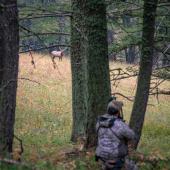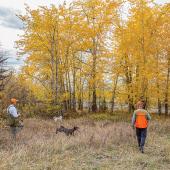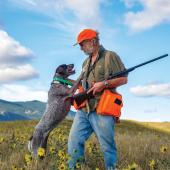This Land is Our Land
In 1985, Montana formally created Block Management Areas (BMAs), which provide free access to private lands across the state for hunting big game, upland birds, and waterfowl. Some of these areas are adjacent to historically isolated public lands, which you can reach by signing up to hunt that BMA. This is a cooperative program between private landowners and Montana Fish, Wildlife & Parks (FWP); the landowners receive compensation for opening their land to hunting, and hunters have free access to some of the finest habitat and hunting in the United States. BMAs are open to both resident and non-resident hunters, and the funding for the program comes from the sale of various resident and non-resident hunting licenses. For last year’s hunting season, there were nearly 1,300 enrolled landowners allowing access to over 8.5 million acres.
One of my most memorable BMA hunts was with two of our German wirehairs—ten-year-old Duke, our oldest dog, and Chukar, our six-month-old. Joining us for the hunt was my friend Kris VanLuchene, who had just passed his hunter safety course and was excited to head out on his first bird hunt.
Once we reached the site, we let the dogs out of the pickup and headed out across a large expanse of sagebrush. Duke ranged out about 75 yards and Chukar bounded along after him, doing his best to keep up. After 20 minutes, Duke slammed on point and Chukar backed him. I motioned for Kris to go up and flush the birds. As soon as he did, a group of six sharptailed grouse exploded out of the sage. Kris got off a shot and brought down a large male. While Duke went to retrieve, Chukar remained on point and I walked toward him to flush another group of three birds. As they flew away, I shot one and Chukar made his first retrieve, sprinting back toward me with the bird between his jaws. I was proud of Chukar’s performance on his first hunt, and Kris was thrilled to get his first bird. Montana sportsmen across the state enjoy great hunts just like these, thanks to our Block Management system—by far the largest and best hunting-access program in the country.
How BMAs Work
Each of Montana’s seven hunting regions has a Block Management coordinator who works with private landowners and signs them up for the program. Landowner participation is voluntary, and contracts for each area are negotiated annually in the spring and summer. After the landowners are enrolled, each region publishes a booklet listing all of the areas open with the general location, acres, dates open to hunting, BMA type, primary hunting opportunities, the hunting district, the name of the map where the area is located, and any additional information. The booklets are available in mid-August and can be ordered by phone or picked up at each region’s local office. The Bozeman office, located on S. 19th, has detailed maps of each of the 83 BMAs in Region 3 showing the boundaries, the rules and restrictions, where and how to gain access, and what hunting opportunities are available. There are also copies of the main BMA booklets for all the other regions.
There are two types of BMAs. Type I allows hunters to administer their own permission. Each of these areas has sign-in boxes usually found at one or more locations on roads bordering the area. Each box has a sign-up form and maps for that area. The hunter must fill out the form, leave one copy in the box, and place the second copy on his dashboard. Type I BMAs normally have no limit on the number of hunters. Type II areas require the hunter to contact the landowner or an FWP staff member who issues permissions slips. Type II areas often require advance reservations, limit the number of hunters, and assign special areas to hunt.
Our Local BMA
Region 3—comprising the area within a two-hour drive from Bozeman—has (as of this writing) 98 landowners signed up for 2012, encompassing over 545,000 acres available for hunters. This is similar to last year, as most landowners like the program and continue to participate year after year. While this region has one of the smallest amounts of acres in the program, we still have quality hunting for upland birds and big game in our back yard.
The area to the south and west, around the Sheridan and Dillon area, is a good bet for Huns and sage grouse. There are also mountain grouse—ruffs, blues, and spruce grouse—in the various ranges around southwest Montana. The area south of Dillon is comprised of large ranches—most of them are Type I—and makes for some great waterfowl hunting. Several of the ranches with land bordering Clark Canyon, Lima Reservoir, and the Red Rock Creek National Wildlife Refuge have excellent duck hunting before the water ices up. Many of the BMAs in this area are also open to elk, white-tailed and mule deer, and black bear hunting.
The area north and east of Bozeman has a number of areas located near Hwy. 89 that are good for sharptailed grouse, sage grouse, and Huns. This area also has a fair amount of antelope, and the forest and mountainous areas have good elk and deer hunting.
North and west of Bozeman, there’s a nice mix of BMA and public land (mostly BLM) around Whitehall, around Canyon Ferry Lake, and north of Helena. Canyon Ferry is a prime spot for geese and both diver and puddle ducks, and also has good pheasant hunting; over the years, the Bozeman and Helena chapters of Pheasants Forever have improved habitat by planting shelterbelts and food plots. Some of the best BMAs in this area are the several large ranches north of Helena, which offer good hunting for elk, deer, and mountain grouse.
Tips from a Native
I find the best time to hunt the BMAs is during the middle of the week, as weekends can get crowded. A dog that reaches out and covers a lot of ground will significantly improve your chances of finding birds. The late season, when there is snow on the ground, can be a good bet for pheasants. Remember to carry water for your dogs and keep a first-aid kit in your rig.
The Future
The future of Block Management depends on you, the hunter, to conduct yourself in a legal and ethical manner, to respect landowners’ property, and to follow the rules and restrictions for each area. Hunting season for mountain grouse, sage grouse, sharptailed grouse, and Hungarian partridge all open up September 1. FWP provides some BMA maps electronically on their website. So get your license, download or pick up a few maps, and get out and enjoy our BMAs here in Montana this fall.
Chuck Johnson owns Wilderness Adventures Press, publishers of hunting, fishing and other outdoor books. He writes a column for Pointing Dog Journal and is the author of Training the Versatile Hunting Dog.














